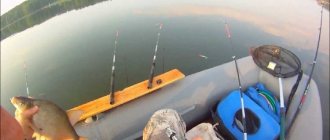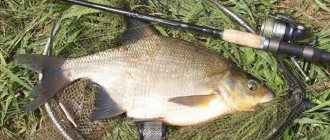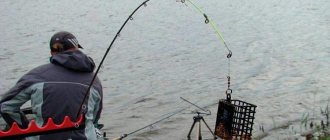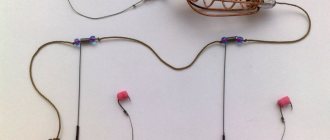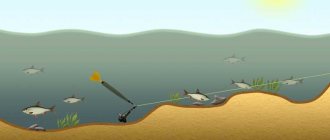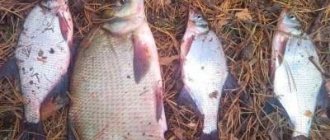see also
Comments 26
Damn it looks kind of scary...
if you catch the “guts” correctly, there will be no “guts”, but the tackle is spring fishing line 02 on top, 2 white and red beads knock on the bottom, a cloud is created, the beads smoothly descend, the fish (white) hits it on the nod, bite - hooking, basically hooking behind the n. use the lip when the fish has no appetite
r.s. When the fish inspection department approaches, quickly bite the line!
I haven’t seen it, but I’ve heard about such a tackle, we call it a tyrant, they catch bleak on their belly
The fish inspector can get caught with such a device!
This is a “purple bag”. A barbaric and merciless poaching tackle.
This section of the site contains links to many of our interesting fishing crafts that you can make at home. Here you will find guides, diagrams and tips for creating a variety of lures, crayfish traps, hooks, tackle, and other various fishing equipment.
The largest share of the presented homemade products relates to baits, both spinning baits (wobblers, mandules, spinners, gliders, pears, silicone baits) and feeder baits (feeders, groundbaits, cereals, springs, elastic bands).
At the end of the article, we collected from the Internet about a hundred of the most interesting, in our opinion, photographs of various homemade products. We highly recommend viewing).
Select a topic that interests you and click on it to go to the desired article.
DIY wobblers

Mandula for pike perch

DIY feeder feeders
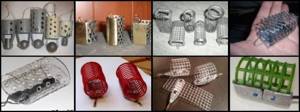
Homemade crayfish
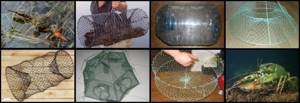
DIY silicone baits
Do-it-yourself spinner “castmaster”

Homemade floats
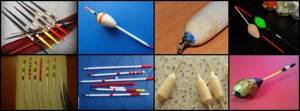
Ramming at home
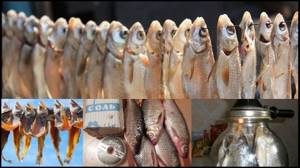
Bait for crucian carp
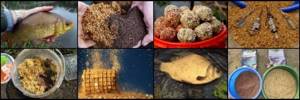
Tackle “crucian killer”

Kwok for catfish

How to make cake for fishing

Homemade bait for feeder
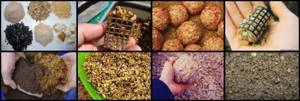
Releases for wobblers and spinners

Nipple for carp and crucian carp

Tackle "pear"

Transom for an inflatable boat

Equipment
Catching pike with crab involves harsh conditions - great depth, strong currents, large fish. Therefore, you will need powerful and strong tackle. A standard good winter pike fishing rod will do. Northern fishermen generally don’t bother using fly rods. They are a willow stick with reels on which about ten meters of 0.4-0.5 fishing line is wound. It is better to place a metal leash in front of the bait, especially when hunting for a trophy.
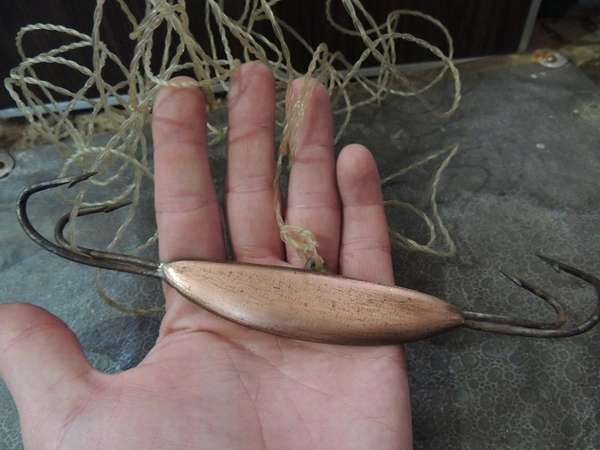
Fishing in the USA

The videos were taken from open sources and posted here for informational purposes, to broaden the horizons of Russian-speaking fishermen.
Some Russian fishermen have a very distorted idea of fishing in the USA. They seriously believe that all American fishermen catch fish in order to release them. It is such stupidity to consider all the inhabitants of the Earth to be the same evil and narrow-minded sadists as you.
Catching catfish by hand
Catching catfish by hand
For the query noodling catfish, Google returns more than 500,000 sites!
American women also take part in catching catfish with their hands.
Purple fish
A selection of videos about fish turning purple in the USA can be found on the “Fish Greening” page. Very informative - be sure to watch them.
TV is the greatest sorcerer! People are so brainwashed that the cotton wool does not come out of their skulls, even when you show them the obvious. But you have to try. Let's see how things stand with the purple fish in a country in which men are armed.
Popular video about fish turning purple in the USA:
Upbeat country music. Fishing is an adventure! Another video of American anglers catching fish below the dam. Not only are they openly engaged in purging, but they are also “banned.”
Video with American children. They cheerfully fish under the supervision of American parents:
You can easily find hundreds of videos of fish turning purple in the USA. Wild country! By the way, you are sitting at an American computer with an American operating system and American software. In your head, tied with an African ribbon, do thoughts about life without computers, phones, ink in the printer, or fillings in your teeth come into your head? Can you imagine your life without the Internet?
Guess at once where such tees for purple fish are sold:
Why is bream caught on spinning baits?
Many species of fish that lead a peaceful lifestyle in their youth, having reached large sizes, begin to feed on fry. Bream is no exception, although most anglers find it hard to believe. After all, after opening the abdominal cavity, no fragments of small fish are found in the stomach. The fact is that before swallowing food, the bream carefully grinds it with its pharyngeal teeth. Therefore, a kind of porridge from ground fish meat already ends up in the stomach.
Bream does not always hunt for small things; it feeds most actively on live fish during the period when the fry is growing.
Depending on water temperature and region, the bite may begin in June or July. This is interesting!
Fans of spinning bream fishing have noticed that artificial baits catch only healthy specimens without parasites. Although in the same area of the reservoir, individuals infected with the Ligulidae are also caught on a feeder or float. Thus, we can definitely say that targeted fishing for bream using spinning tackle can bring good results.
Tactics and fishing techniques
To catch bream using rubber or spoons, you need to correctly present the artificial bait. The feeding horizon of the fish and the degree of its activity should be taken into account. There are several tactical approaches to which the appropriate wiring is selected.
- When fishing with rotating spoons, uniform wiring is used. Sometimes it can be varied by short jerks, changing the direction and speed of reeling. Turntables work well in the middle layers of water, when bream feeds at mid-water in the summer. Using spinners with petals, you can successfully hunt for fish in the spring in shallow water areas up to 2 m deep. You should start fishing with baits no more than 3 cm long, and if there are no bites, switch to smaller models. To arouse the interest of the bream, the threesome is camouflaged using white cambric and a bunch of red threads.
- Silicone fish expand the technical capabilities of the fisherman. Beginner spinning fishermen can animate baits using uniform wiring with various variations. Depending on the weight of the jig head, you can fish both shallows and deep holes. The method of dragging along the bottom on clean ground works well. On a rocky bottom, such wiring will lead to an instant hook.
- The jig technique for spinning bream fishing stands apart. It differs from the classic step, which is used when catching a predator. The difference lies in the length of the pause between windings of the fishing line. During a stop, the bait floats in a layer of water, imitating a worm or fry that is struggling with the current. The bream grabs the prey so greedily that the hook ends up in the fish's gills. Even when the bait sinks to the bottom, there is no need to rush to continue retrieving. At the moment of falling, a cloud of turbidity is formed, attracting the attention of the fish. The bream thinks that the prey is trying to burrow into the mud and sucks it in with its powerful mouth. At this moment, a light tapping and small trembling is transmitted to the fishing rod. After waiting a second, you need to make a short hook with your hand.
It is important! You should not hook the bream strongly and sweepingly, as the soft tissue of the oral cavity is easily torn. It is better to loosen the clutch to soften the hard kick.
Unfortunately, bream caught on a spinning rod can rarely be released back into the reservoir. The catch-and-release principle cannot be implemented due to disruption of the gill tissues. Once injured by a hook, the fish will not be able to survive. In this regard, the fisherman’s “humanitarian brakes” should work. It is enough to catch 2-3 fish to finish fishing and thank the reservoir for the pleasure received.
Selecting a location
Any fishing begins with choosing a place where you are going to catch fish, and it doesn’t matter whether it’s predatory like pike perch and pike or peaceful like bream, roach, crucian carp. Although the word “peaceful” needs to be put in quotation marks, since this article is aimed at destroying established stereotypes regarding bream specifically. And in the future you will only become even more convinced that my words are not empty space.
Bream, due to their way of life, usually stays on rocky and shell-like areas of the bottom, and the depth at these points can reach 6-8 meters or just 1-1.5 meters. I consider the presence of a weak current to be an important condition; in areas without a current I have not seen any fish or they are very small in size. Larger bream and bream (700 g and above) prefer to stay in precisely those areas where there is a flow of water, even if there is depth there, as they say, the chicken will cross the ford. It was possible to catch bream under 2.5 kg from depths of 80 cm-1 m, provided that the bottom was completely covered with shell rock.
You can also meet large, seasoned bream on clay and sandy-silty bottom sediments, but there it mostly rests and only occasionally feeds. Fish actively feed in the above-mentioned rocky areas, and you are very lucky if colonies of shells are found among large boulders - dreissena or pearl barley. Well, if in a section of the river, in addition to large stones and shell deposits, bushes of aquatic plants are also found, then such a place will definitely attract bream, and us too in terms of catching this very bream.
An important factor influencing the presence or absence of bream is the influx of fresh water, not only from the banks in the form of springs or streams, but also the presence of such on the bottom relief. This can only be confirmed by the presence of bream at the fishing points. If you're really lucky, you can walk waist-deep into the water in light shoes and immediately feel fresh, cold water with your feet, which cannot be confused with anything else. It is precisely these areas that large bream adores, especially in the summer heat, when the temperature of the surrounding water exceeds 24-25 degrees.
It will be interesting to note that areas with such outlets of underwater springs form a kind of feeding table. Cold water, the temperature of which usually does not exceed 5-6 degrees, goes along the very bottom, without mixing with the warmer river water, that is, the presence of a bottom thermocline is evident. Moreover, the density of cold water is such that all the food carried by the current never sinks to the very bottom, but hovers from it at a height of 25-30 cm. And the bream, enjoying the cooled streams of water, just as we relax under the cool currents of air from the air conditioner in the summer heat, rest and feed in the same way, catching passing food precisely along the border of cold and warm water. I think this can explain the lack of bites on bottom gear in a seemingly interesting fishing spot. The whole point is, as I see it, that the feeder of the feeder tackle simply falls into this very cold zone and ceases to attract fish. The bream simply passes a little above the hooks with the nozzle.
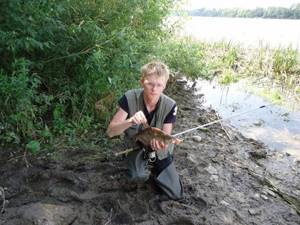
A very successful area for fishing is also the presence of large obstacles to the flow, for example, a transverse boom made of stones or branches, which sharply slows down the flow and helps wash out the hole behind it. And the stronger the current, the larger and more powerful the partition, the deeper the hole is formed behind the obstacle. The bottom of such local depressions usually consists of large stones, logs and settled shells, and these are the most interesting places for bream! Closer to August, in the central zone there is an abundant growth of filamentous algae, popularly called mud. This mud covers stones and branches, creating long strands that very well protect the water column underneath from too bright light and contain a lot of different insects and worms that become food for fish.
If you find at least one of the places described or similar to them, rest assured that bream is somewhere nearby.
Sterlet habitats in winter
When catching sterlet, you must remember that the fish stays near the shore only in warm and sunny weather, when the water level in the river or lake is high enough. In summer it can be caught just 15-20 meters from the shore. As soon as the reservoir begins to become shallow, and the first cloudy days begin with lower temperatures, the sterlet begins to move away from the shore, seeking shelter in deep holes. If an individual lived and hunted in small small tributaries, with the advent of cold weather, it swims into a large and wide river, which has many “wintering” holes, with a depth of 20 meters and above.
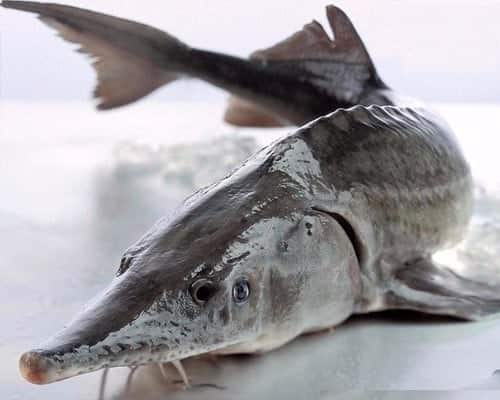
At the first drop in water level, the sterlet descends to the lower reaches. For all rivers of Siberia, the best reference points for fish habitat are the cardinal directions, and massive concentrations of sturgeon at low temperatures are observed precisely in the north of the reservoir. Winter fishing for sterlet is also interesting because in the pits the fish behave passively, practically do not feed, simply waiting for prey, and therefore the most important thing for the fisherman is to find the best place for a large number of sterlet to accumulate.
Sterlet tackle for winter fishing
Since the fish spends the entire winter at the depths of the reservoir, when going for winter fishing, it is necessary to wait until the ice on the river or lake becomes at least 20 cm thick. If you feel the “movement” of the ice floe when moving or hear crackling, immediately return to the shore. Attention! Do not make holes near gullies or too close to each other. This may cause the ice to crack. The distance between holes should not be less than 8-10 meters. Winter fishing for sterlet is carried out mainly with float tackle or a nod fishing rod. In both cases, for fishing you will need the following materials and equipment: • 2-3 durable fishing rods; • several thin lines of various diameters; • jigs and hooks; • bait (worm, maggot, whitebait); • high chair; • ice ax; • gaff; • extractor. Sterlet is a cautious fish, and during the wintering period it is reluctant to take baits that are unfamiliar to it, and does not swim at all to an object that is too bright and large. Therefore, you need to choose a strong but transparent fishing line, and use the usual live bait or bait for sturgeon as bait. In this case, it is better to make a combined tackle, tying at least 2-3 hooks onto the fishing line.

